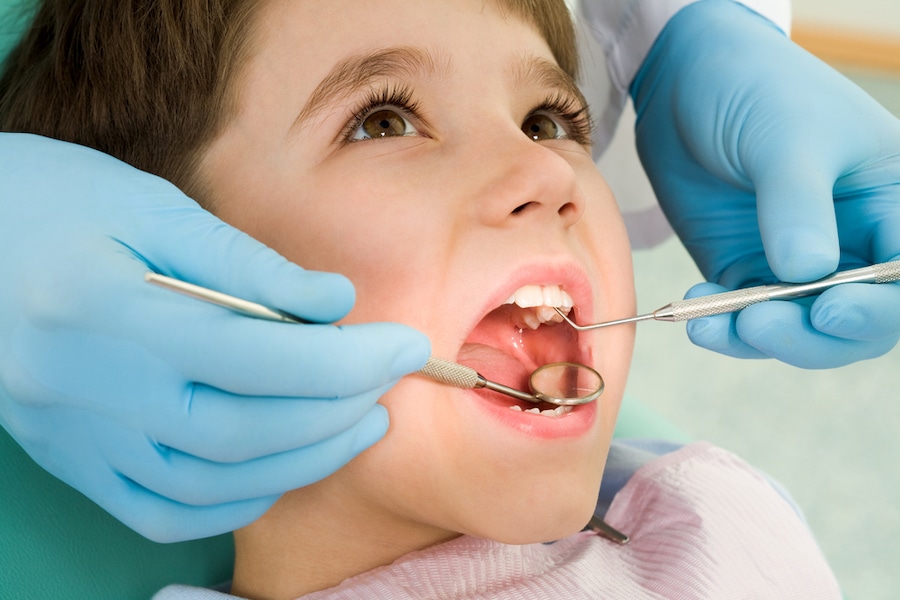The American Academy of Pediatric Dentistry recommends dental visits starting before the age of one. This leaves many visits to the pediatric dentist in front of new parents as they navigate the world of caring for their child’s overall health.
When a cavity is discovered on a baby tooth however, many wonder if it is worth filling the cavity at all.
The short answer is: yes, absolutely. If left untreated, these cavities will persist until they are an expensive and involved problem to fix.
Why is that? Our answers below.
What Are Cavities?
When a cavity (also known as dental caries) forms, it is done so through specific germs within the mouth (particularly, mutans streptococcus). These germs affect a child’s teeth by breaking down the tooth enamel and creating a stop for a cavity to grow.
While children are not born with mutans, cavities are present in 42% of children aged 2-4 according to this study from the National Institute of Dental and Craniofacial Research. Often these germs are first introduced when sharing utensils with a sibling or parent that has mutans in their saliva. This is particularly true if the other individual is prone to cavities and tooth decay themselves.
The Importance of Baby Teeth
Baby teeth, also known as primary teeth, are important training wheels for your child’s mouth.
One of the main jobs of baby teeth is to help lead the way for a straighter smile as permanent teeth grow into place. Losing primary teeth too early due to decay can cause a greater need for braces in the long term.
Furthermore, the texture and composition of baby teeth are softer and demand more care than their permanent counterparts. As such, if a problem occurs in the baby tooth, it has a higher likelihood of affecting the underlying tooth or adjacent gum tissue, leading to a host of problems from pain, infection, and difficulty eating or speaking normally. This greatly reduces a child’s overall oral health and wellbeing.
Why Do Cavities in Baby Teeth Need to Be Filled?
While there are several reasons for this, let’s think about an example.
If baby teeth last until 6 years of age, with molars lasting several years longer until 10 or beyond, the argument that baby teeth will simply fall out before the cavity is a problem is untrue. If a child develops a cavity at age 4 on a back molar and the problem persists until the age of 10, not only will the cavity have a chance to cause pain, difficulty talking, and difficulty eating, but it can also spread to the gumline and surrounding teeth.
The younger such cavities begin, the longer they must persist until the tooth is ready to fall out. Implications of leaving a cavity untreated for such a length of time grow increasingly severe as time goes on, especially given the softer nature of primary teeth.
This turns a single minor cavity into a full mouth problem– once which may require hospital care to perform the necessary number of extractions, fillings, and other needed dental work.
Treatment Options for Pediatric Cavities
As seen above, the potential side effects of allowing a cavity to persist in your child’s mouth can be unnecessarily severe. This is why it is imperative that parents treat any existing cavities as quickly as possible.
As parents begin researching dental treatment options, they often ask themselves: how do dentists fill cavities in toddlers and young children? What if they need a tooth pulled?
The good news is that many different procedures exist to address all states of childhood cavities and help prevent tooth decay in the future
- Remineralization: This is the natural process of a tooth essentially “healing” its own cavity. Through a combination of oral hygiene and good bacteria found in the mouth, smaller, surface cavities can sometimes resolve on their own.
- Fillings: The cavity is cleaned, drilled, and filled to prevent spread or worsening
- Extractions: If the cavity is particularly bad or at risk for damaging surrounding teeth and gums, your dentist may opt to extract the tooth entirely.
Depending on the extent of the work your child needs and their individual temperament, there are several courses of action your dentist might recommend for these procedures. These range from simple local anesthetics, to nitrous oxide (laughing gas), and in cases where work is more extensive, potentially a hospital visit and general anesthesia.
Prevention is the Best Care
Preventative care is the best care when it comes to childhood cavities. If the tooth decay never forms, there is no need to fix anything.
Some of the most effective methods of preventative care include the following:
- Limit sugary drinks such as juice and soda
- Practice and teach good brushing habits
- Practice and teach good flossing habits
- Use a fluoride toothpaste
- Schedule regular twice-yearly trips to the dentist, even if not all the teeth are showing
As kids get older and desire more autonomy, it is especially important to make sure they are still caring for their teeth in the correct way.
Children learn by observing, making this a great opportunity to model proper brushing and flossing habits that last the rest of a child’s life.
A Family (Friendly) Dental Practice
EVDP starters as a family owned business, so we know the importance of having a dentist that is not only experienced, but is someone who you can trust. As Arizona residents ourselves, we have been a staple to the Mesa Area servicing families much like our own to help give you the smile you deserve.
Established in the 1980s, we take great pride in having local clients who receive the best dental care and the best service.
Are you living in Arizona? Whether this has been your long time home, or you’ve settled here recently, we are happy to help you with all your dental health needs. Please call us at 480-838-3033 for a consultation with our dentist. We are only one call away from a healthier smile.

